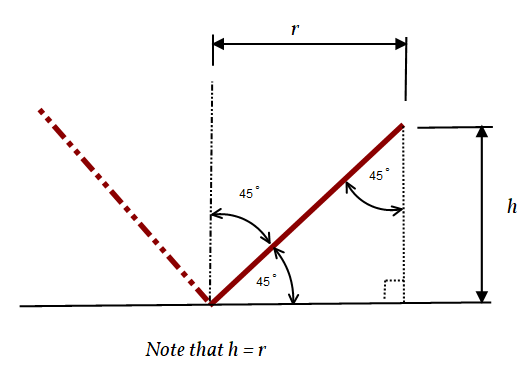How to answer these question using differentiation ?

The answer is #3/(4pi) cm (min)^-1 #

The answer is
2 Answers
See the explanation: using 'older notation'
Explanation:
Let the radius of the water surface at any point be
Let the height from the vertex to the water surface be
Let the time in minutes be

Volume of the water is
We are given that the volume of water discharged into the cone is 3cm per minute
Given that there is a relationship to the height and time we have
However, the shape of the cone is such that
Divide both sides by 3
But to answer the question we need
At
The required rate is
Explanation:
Let us set up the following variables:
# { (t, "time", min), (r, "radius of the top of the water ate time " t, cm), (h, "height of the water at time "t, cm), (V, "Volume of the water at time "t, cm^3) :} #
The volume of the cone is given by the standard formula:
# V = 1/3pir^2h#
As the angle between the vertical and the slant is
# V = 1/3pih^2h #
# :. V = 1/3pih^3#
If we differentiate wrt '
# (dV)/(dt) = d/dt {1/3pih^3} #
# \ \ \ \ \ \ = 1/3pi \ d/(dh) {h^3} \ (dh)/dt #
# \ \ \ \ \ \ = 1/3pi \ 3h^2 \ (dh)/dt #
# \ \ \ \ \ \ = pi h^2 \ (dh)/dt #
We are given that "Water drop into the container ate a rate of
# (dV)/(dt) = 3 \ \ # , a constant
And so we have:
# pi h^2 \ (dh)/dt =3 #
# :. (dh)/dt =3/(pi h^2) #
The question asks us to calculate "the rate at which the water level is increasing when the water level is
# [ (dh)/dt]_(h=2) = 3/(pi 2^2) #
# \ \ \ \ \ \ \ \ \ \ \ \ \ \ \ = 3/(4pi) #
# \ \ \ \ \ \ \ \ \ \ \ \ \ \ \ ~~ 0.2387 \ cm^3 mi n^(-1)#


